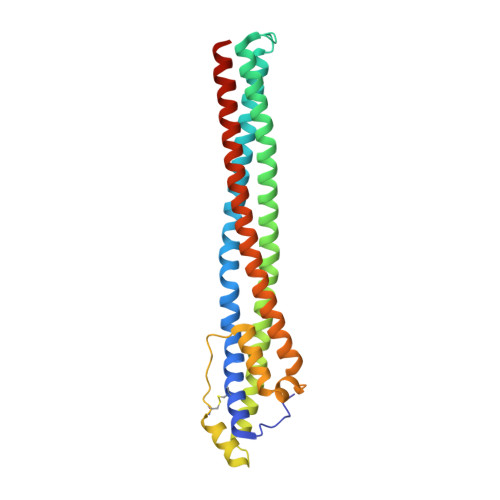Structure of the trypanosome haptoglobin-hemoglobin receptor and implications for nutrient uptake and innate immunity.
Higgins, M.K., Tkachenko, O., Brown, A., Reed, J., Raper, J., Carrington, M.(2013) Proc Natl Acad Sci U S A 110: 1905-1910
- PubMed: 23319650
- DOI: https://doi.org/10.1073/pnas.1214943110
- Primary Citation of Related Structures:
4E40 - PubMed Abstract:
African trypanosomes are protected by a densely packed surface monolayer of variant surface glycoprotein (VSG). A haptoglobin-hemoglobin receptor (HpHbR) within this VSG coat mediates heme acquisition. HpHbR is also exploited by the human host to mediate endocytosis of trypanolytic factor (TLF)1 from serum, contributing to innate immunity. Here, the crystal structure of HpHbR from Trypanosoma congolense has been solved, revealing an elongated three α-helical bundle with a small membrane distal head. To understand the receptor in the context of the VSG layer, the dimensions of Trypanosoma brucei HpHbR and VSG have been determined by small-angle X-ray scattering, revealing the receptor to be more elongated than VSG. It is, therefore, likely that the receptor protrudes above the VSG layer and unlikely that the VSG coat can prevent immunoglobulin binding to the receptor. The HpHb-binding site has been mapped by single-residue mutagenesis and surface plasmon resonance. This site is located where it is readily accessible above the VSG layer. A single HbHpR polymorphism unique to human infective T. brucei gambiense has been shown to be sufficient to reduce binding of both HpHb and TLF1, modulating ligand affinity in a delicate balancing act that allows nutrient acquisition but avoids TLF1 uptake.
Organizational Affiliation:
Department of Biochemistry, University of Oxford, Oxford OX1 3QU, United Kingdom.














